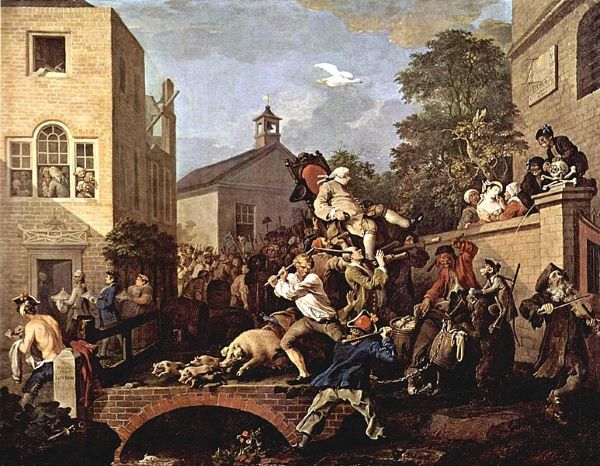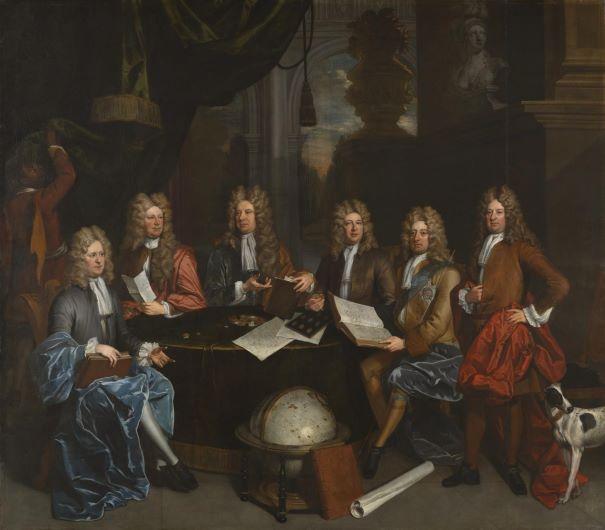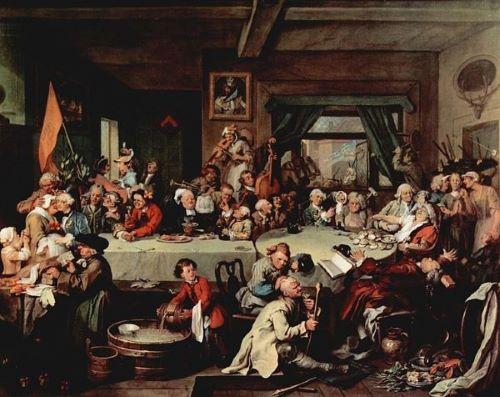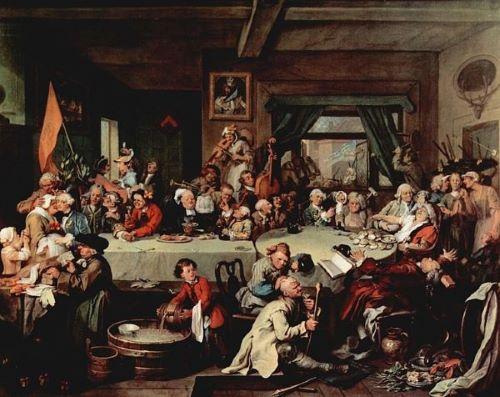Abstract
Parliamentary elections were the sites of both polite sociability and impolite, divisive, abusive and highly unsociable behaviour. As moments of intense social interaction between parties, candidates and electors, elections could be significant sites of sociability and even festivity, in person and in print; but they could also generate unsociability in the form of drunkenness, hostility, bitter partisanship and even violence that many commentators saw as impolite and damaging to the political and social culture.
Parliamentary elections were the sites of both polite sociability and impolite, divisive, abusive and sometimes violent and highly unsociable behaviour.1 They were moments when elite and popular notions and expectations of sociability interacted and sometimes collided. Elections channelled accepted forms of sociability into political expression at the polls but also invented new modes of communication and created an instrumentalised sociability for partisan purposes. As such, elections presented in microcosm both a wider culture, or rather cultures, of sociability and the subversion or manipulation of sociability for political purposes. The political parties and interest groups that fought them were sociable for their partisans but anti-social to those outside them who were excluded or demonised.
- 1. This article does not cover local elections, though many of the same points apply.
Electioneering increased in importance because of the increased frequency of elections between 1694 and 1716, and a commensurate increase in the percentage of adult males able to vote (to about 18%, higher than at any time until after the Second Reform Act in 1867).2 Whilst the Septennial Act did introduce less frequent elections and the number of contested elections reduced in the first half of the eighteenth century, partisan divisions were reanimated in the second half and there were many constituencies, especially ‘open’ ones with large electorates, where the outcome had to be keenly fought for.
- 2. J. H. Plumb, ‘The Growth of the Electorate from 1600 to 1715’, Past & Present, 45 (1969) p. 90-116; Frank O’Gorman, ‘The Electorate Before and After 1832’, Parliamentary History, 12 (1993), p. 171-83.
Even before an election had been announced party leaders sometimes gathered for sociable meetings that mixed business with pleasure. Thus a group portrait of the ‘Junto’ (see illustration above), the leaders of the Whig party, depicts them shortly before the disastrous election of 1710 sitting around a table looking at antique medals and prints as though they were a club of connoisseurs, and probably depicts the earl of Orford’s house near Newmarket, where politics could be combined with horseracing. Even without such grand meetings, elections occasioned social visits and letters between those seeking to marshal an ‘interest’ behind a candidate. The well-attended Grosvenor canvassing party at Chester in 1818 even included a band of sixty musicians (who were paid so poorly in 1812 that they voted for the opposition!).3
- 3. O’Gorman, ‘Campaign Rituals and Ceremonies: The Social Meaning of Elections in England 1780-1860’, Past & Present, 135 (1992), p. 84, 102.
Once (and often before) an election had been called, electoral ‘treating’ became a routine, and often expensive, form of canvassing for votes. Food and drink were distributed in large quantities from inns and alehouses, whose keepers made large profits from the huge sums billed to candidates. The 1807 Yorkshire election, with its high number of voters, cost candidates over £200,000, the equivalent of well over £8m in today’s money. Whether such expenditure constituted ‘sociability’ was a disputed point. Its defenders called it ‘hospitality’ and saw it as a customary obligation for the elite to provide lavish entertainment for supporters. Many voters expected to be supplied with alcohol, at the very least; and elections were occasions when social distinctions could be temporarily suspended if not inverted. In 1679 an election agent told a correspondent ‘You would have laughed to see how pleased I seemed in kissing of old women, and drinking wine with handfuls of sugar, and great glasses of burnt brandy, three things much against the stomach.’4 In 1705 Sir Roger Jenyns similarly rode ‘with a boy after him through the fens kissing the farmers’ wives and begging their recommendation to their husbands’.5 As these examples suggest, electoral sociability could extend to women, even though very few could vote, and to a wider social group than the formal franchise implied. Sociability thus created a large number of vicarious electors and eroded social distinctions.
Critics, however, saw such sociability as dangerous, regarding electoral entertainments as a form of bribery (an act of 1696 sought to clamp down on ‘treating’ in a vain attempt to rid elections of corruption), and they were hostile to the subsidies increasingly offered by the Treasury for government-favoured candidates. The more puritanically-minded also saw such entertainments as debauched bouts of drunkenness. In 1696 a disgusted John Evelyn expressed dismay at the ‘confus’d, debauch’d and riotous manner of electing members’ in which men were forced ‘to bribe the votes of a drunken multitude, more resembling a pagan bacchanalia than an assembly of Christians’.6 Hogarth’s depiction of an election entertainment at the 1754 Oxfordshire election captures an unruly sociability in which a toothless woman embraces one candidate and a drunk man blows smoke into the face of another, around which revolves a scene of carnivalesque feasting and drinking, with a hint of violence as a brick is thrown at the head of the candidates’ electoral agent. Indeed, violence was not uncommon at elections, with some constituencies (Coventry, for example) gaining a reputation for it. Election entertainments thus ranged from polite sociability at one end of the spectrum, through to impolite unsociability at the other.
- 6. Memoirs Illustrative of the Life and Writings of John Evelyn, ed. W. Bray (New-York: G. P. Putnam & sons, 1870), p. 721-2.
At election feasts or drinking sessions, election ballads (available since the Restoration) and songs were produced to catch the mood and enhance sociability (and hence also solidarity) among a group of voters. By the mid-eighteenth century printed collections of such songs, together with poems and other electoral ephemera (such as candidates’ advertisements about electoral meetings), were published in volumes as collectables. The collector of one early miscellany, relating to a York election, called his work ‘an Election Opera’, in emulation of recent ‘sing-song plays’ such as Gay’s Beggar’s Opera.7 Yet such print could also veer into impoliteness and divisiveness. A 1786 publication collating poems, songs and public notices relating to a Norwich election, included a public notice from one candidate’s agents that ‘several abusive songs and handbills’ that were ‘indecent and illiberal’ in the way they reflected on his electoral rival had been ‘obtruded on the public’.8 Much of the other material did not pull its punches and the elite that bought such works must often have found the content disconcerting for the vehemence of its critiques of the gentry candidates. Indeed, in 1768 a Somerset song disdained the ‘rich bullies’ who oppressively expected voters to set aside their right to choose whichever candidate they wanted.9
Electioneering also took place in printed tracts and periodicals. From the 1640s onwards a genre of electoral advice literature emerged that became an important part of eighteenth- century political culture. In the 1690s such print was even tailored to particular contests. There were over two hundred pieces of electoral propaganda published in the period 1679-1715; by the 1780s this number could be expected for a single contest in a single constituency, often through the use of quickly-produced handbills or broadsides that provided real-time information about the progress of a poll. In all print there were the same ambiguities about sociability that existed on the ground. Electoral print invoked readers as an impartial ‘public’ and urged them to participate in a rational casting of votes, unprejudiced by inducement or intimidation. It invoked an idealised, persuadable voter. Yet many electoral tracts and reportage veered into name-calling, abuse and railing that was seen as violating the norms of polite sociability. A 1705 election tract lamented that the aggressive tactics of low churchmen were ‘a piece of incivility’ and that divisions had become ‘like the raising of a civil war amongst us at every election’.10 ‘Black-lists’ of how MPs had voted were circulated with hostile glosses and much of the literature was said to be intent on deceiving rather than informing the public.11 Such printed electoral advice circulated in large quantities and was, ironically, sometimes designed, through a dialogic format, to emulate sociable interaction between voters.
In the second half of the eighteenth-century it became usual for candidates to make speeches (often subsequently published) when they were nominated, hustings that brought together large crowds. Voting was itself a public activity in which polite sociability was always precarious. Without a secret ballot, voters either collected as a group to shout their preferences or, if a poll was demanded, queued to have their names taken – and hence their choice was a public affair, known by neighbours, landlords and opponents alike. This could result in later reprisals, such as being turned out of a lease or losing trade. The conduct of the poll could be orderly but was often rumbustious in closely contested elections: voters were intimidated, even set upon, by rivals and the scenes were frequently described in quite chaotic terms in the later petitions presented to the House of Commons detailing reasons why an election should be deemed invalid. The inflamed passions at election time were also given as a reason given for the need to pass the Septennial Act in 1716, as polarisation eroded sociability: partisans could hardly be ‘brought to pay one another the civility of the hat’.12 Elections, it was said, filled the land ‘with drunkenness, opprobrious language, impious oaths and execrations, with violence and party rage, and often with bloodshed’.13 Some thought elections had led to a degradation of culture: ‘riots, tumults, mutual abuses, odious nick-names, personal affronts are kept alive and warm from three year to three year’, complained Daniel Defoe.14
- 12. A Letter to a Friend upon Occasion of the House of Commons Passing a Bill Intituled an Act for Enlarging the Time for the Continuance of Parliaments (1716), p. 19.
- 13. The Alteration of the Triennial Act Considered (1716), p. 33.
- 14. [Daniel Defoe], Arguments about the Alteration of Triennial Elections (1716), p. 2.
Once the poll had been completed another occasion for sociability came with the announcement of the victor and the ‘chairing’ of the new member, an eighteenth century development (it had declined again by the mid nineteenth-century) in which the new MPs were carried aloft in procession that drew in many who had not even voted – another scene in Hogarth’s election series.15 Once again the artist sought to bring out both the sociability of the occasion – the crowd celebrates together with their candidate – and the tensions and inversions involved in such sociability, with the new MP nearly toppling out of a chair carried by an unruly gang and again with echoes of chaotic violence all around. Indeed, chairing could be highly divisive and undermine sociability.16 But it could also be a moment of sociable unity. The chairing, and its process, in Leicester in 1768 brought out ‘the greatest concourse of People ever seen in this Town on any occasion’, though the whole event passed off with the utmost order and ‘Propriety’.17

- 15. ‘The chairing processions were echoed in other processions when candidates entered the constituency’(Frank O’Gorman, ‘Campaign Rituals’, p. 83-4).
- 16. O’Gorman, ‘Campaign Rituals’, p. 111-112.
- 17. An Exact Copy of the Poll taken at the Guild-Hall in the Borough of Leicester (1768), ‘Introduction’.
Chairing was often followed by a dinner or dance. The Election Magazine or Repository of Wit and Politics (1784), relating to a Norwich election, noted (with relief) that the chairing of Hobart and Windham in the Market place had passed off without ‘accident or tumult’ and had been followed by ‘a brilliant assembly’.18 The victorious county MPs that year also held a ‘joyous’ dinner at which celebratory toasts were drunk to ‘The King and Constitution’ and ‘Prosperity to the County of Norfolk’.19
Electioneering, then, was both a highly sociable process with stages and forms that could be socially inclusive and constructive of community; but it could also, through excess, partisanship, different class expectations, social inversions and even violence be highly unsociable and leave a legacy of division.
Share
Further Reading
Barker, Hannah and Vincent, David (eds.), Language, Print and Electoral Politics, 1790-1832: Newcastle-under-Lyme Broadsides (Woodbridge: Boydell & Brewer, 2001).
Chalus, Elaine, ‘Kisses for Votes: The Kiss and Corruption in Eighteenth-century English Elections’, in Karen Harvey (ed.), The Kiss in History (Manchester: Manchester University Press, 2005).
William Speck, Tory and Whig: The Struggle in the Constituencies 1701-15 (London: Macmillan, 1970).
History of Parliament online biographies and constituency articles: https://www.historyofparliamentonline.org


